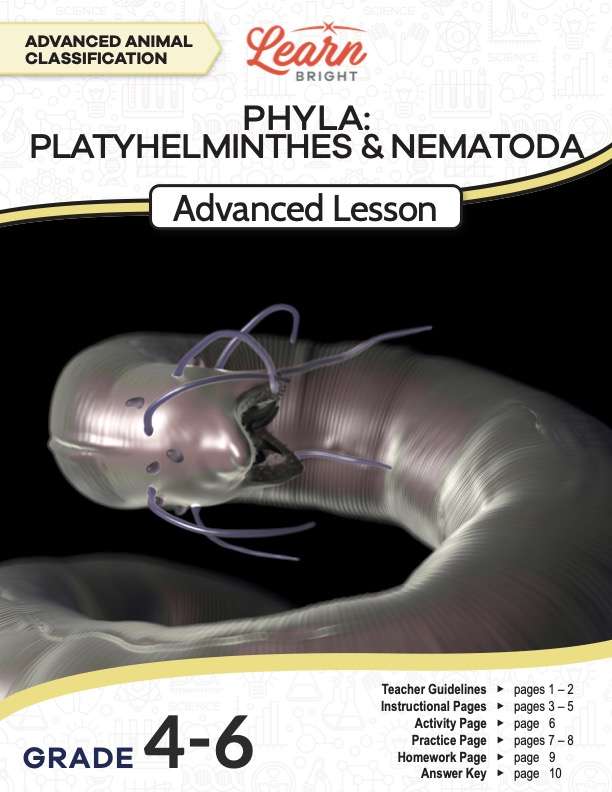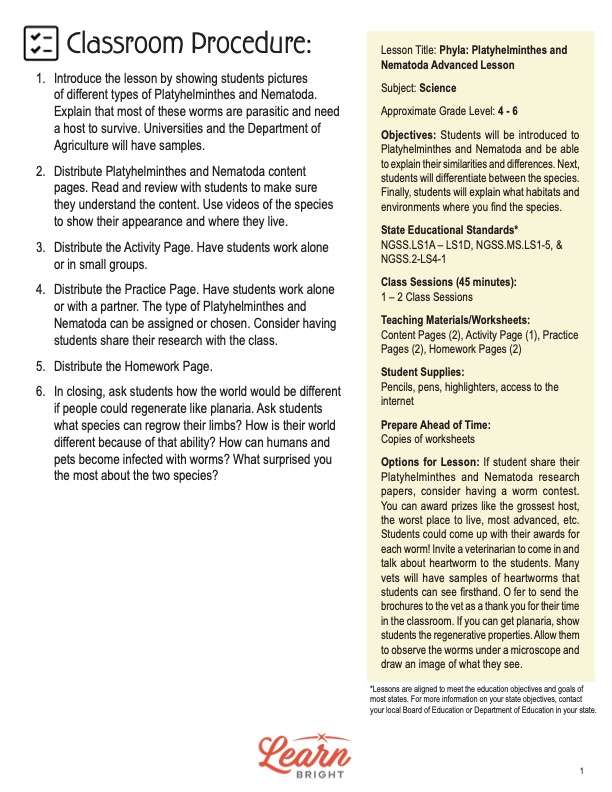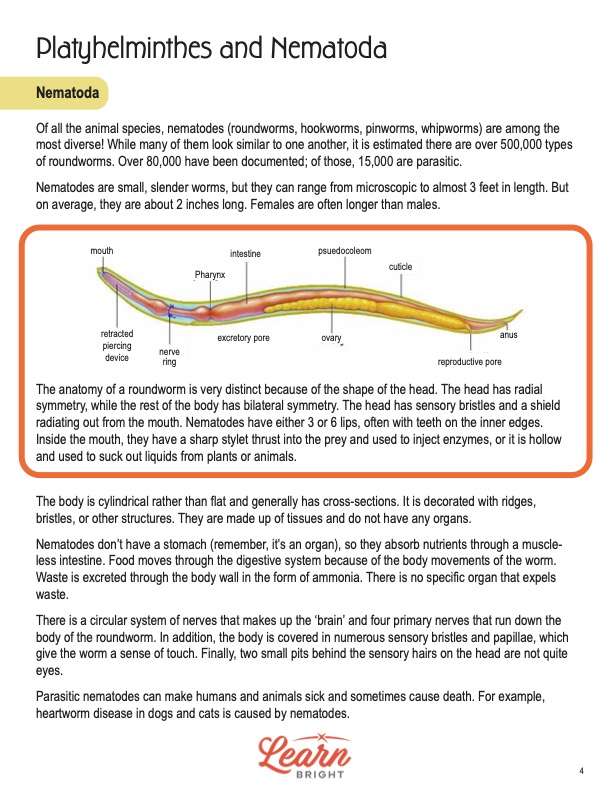Description
What our Phyla Platyhelminthes and Nematoda Advanced lesson plan includes
Lesson Objectives and Overview: Phyla Platyhelminthes and Nematoda Advanced explores the species that belong in these two categories of animals. Students will learn about their similarities and differences. They will also discover information about their various habitats and environments. This lesson is for students in 4th grade, 5th grade, and 6th grade.
Classroom Procedure
Every lesson plan provides you with a classroom procedure page that outlines a step-by-step guide to follow. You do not have to follow the guide exactly. The guide helps you organize the lesson and details when to hand out worksheets. It also lists information in the yellow box that you might find useful. You will find the lesson objectives, state standards, and number of class sessions the lesson should take to complete in this area. In addition, it describes the supplies you will need as well as what and how you need to prepare beforehand.
Options for Lesson
In the “Options for Lesson” section of the classroom procedure page, you will see some suggestions for additional activities or ideas to add to the lesson if you want to. If students share their Platyhelminthes and Nematoda research papers, consider having a worm contest. You can award prizes like the grossest host, the worst place to live, most advanced, etc. Students could come up with their awards for each worm! Invite a veterinarian to come in and talk about heartworm to the students. Many vets will have samples of heartworms that students can see firsthand. Offer to send the brochures to the vet as a thank you for their time in the classroom. If you can get planaria, show students the regenerative properties. Allow them to observe the worms under a microscope and draw an image of what they see.
Teacher Notes
The paragraph on this page provides a little more information or guidance on what to expect from the lesson. You can use the blank lines to record any thoughts or ideas you have as you prepare.
PHYLA PLATYHELMINTHES AND NEMATODA ADVANCED LESSON PLAN CONTENT PAGES
Playthelminthes
The Phyla Platyhelminthes and Nematoda Advanced lesson plan contains three pages of content. Platyhelminthes, also known as flatworms, are soft-bodied invertebrates. There are about 20,000 species of flatworms. Up to 80% of flatworms are parasitic, but a small group is also free living. They can live almost anywhere, from freshwater lakes to ponds and streams to inside debris. Most are found in countries like New Zealand, Australia, Central and South America, and on the islands of the South Pacific. Since most are parasitic, they also live in animal and human hosts.
Tapeworms are Platyhelminthes that live in the intestinal tract of cats, dogs, and many other species. They even live in the intestinal tracts of humans too! Flukes are also parasitic and live in both animals and humans. Tapeworm eggs are deposited in the feces of one species and then consumed by another species. They begin the next phase of the life cycle in the digestive system of their host. Then they mature in the muscle tissue.
Planaria
Planaria are harmless and most often used in biology classes for students to see. They live in freshwater. Their head is black and shaped like an arrow. It has two white spots that can sense light, but those are not eyes. The cool thing about them is that they regenerate!
If you are near water, some Platyhelminthes species will not be far away. Because these worms are small, most people don’t even notice them. While they seem pretty simple, they are more complex than some other animals. They were the first species to develop a mesoderm. This is the tissue that develops into organs and muscles as an organism grows. While they don’t have a respiratory or circulatory system, they do have a simple nervous system, sensory organs, and a small digestive system.
Platyhelminthes get their oxygen through diffusion, and their flatness provides more surface area to absorb oxygen. Most flatworms have a mouth but not an anus. So anything they digest that they don’t want has to go back out of the mouth or be excreted through flame cells. Flame cells have short cilia and microscopic vibrating hairs. The cilia flip and flap to filter out material the flatworm wants to remove.
Nematoda
Of all the animal species, nematodes (roundworms, hookworms, pinworms, whipworms) are among the most diverse! While many of them look similar to one another, scientists estimate that there are over 500,000 types of roundworms. Over 80,000 have been documented; of those, 15,000 are parasitic. Nematodes are small, slender worms. But they can range from microscopic to almost three feet in length. On average, they are about two inches long. Females are often longer than males.
The anatomy of a roundworm is very distinct because of the shape of the head. The head has radial symmetry while the rest of the body has bilateral symmetry. The head has sensory bristles and a shield radiating out from the mouth. Nematodes have either 3 or 6 lips, often with teeth on the inner edges. Inside the mouth, they have a sharp stylet that thrusts into their prey and that injects enzymes. Or it is hollow and used to suck out liquids from plants or animals.
Their bodies are cylindrical rather than flat and generally have cross-sections. They are decorated with ridges, bristles, or other structures. And they are made up of tissues and do not have any organs.
Other Interesting Facts
Nematodes don’t have a stomach (remember, the stomach is an organ), so they absorb nutrients through a muscle-less intestine. Food moves through the digestive system because of the body movements of the worm. The worms excrete waste through the body wall in the form of ammonia. There is no specific organ that expels waste.
There is a circular system of nerves that makes up the “brain” and four primary nerves that run down the body of the roundworm. In addition, its body is covered in numerous sensory bristles and papillae. These give the worm a sense of touch. Finally, it has two small pits behind the sensory hairs on the head, but they are not quite eyes.
Parasitic nematodes can make humans and animals sick and sometimes cause death. For example, heartworm disease in dogs and cats is caused by nematodes. Nematodes cause many problems in sheep, fig wasps, and other insects. They even cause issues in plants by damaging the plant’s root system. This reduces the plant’s ability to absorb water and nutrients. Nematodes can also attack bark and forest trees and cause severe crop losses.
But not all nematodes are detrimental. There are many beneficial nematodes too. Some of them kill garden pests like cutworms and corn earworm moths. And scientists have figured out how to manage many of the harmful nematodes by using marigolds, fungus, and soil steaming. On the last content page is a diagram that explains how animals and humans get infected by some of these worms.
PHYLA PLATYHELMINTHES AND NEMATODA ADVANCED LESSON PLAN WORKSHEETS
The Phyla Platyhelminthes and Nematoda Advanced lesson plan includes three worksheets: an activity worksheet, a practice worksheet, and a homework assignment. Each one will reinforce students’ comprehension of lesson material in different ways and help them demonstrate when they learned. Use the guidelines on the classroom procedure page to determine when to distribute each worksheet to the class.
PROTECT THE PETS BROCHURE ACTIVITY WORKSHEET
Students will work in groups for the activity. The prompt explains that the local veterinarian wants to create a new brochure about heartworm for owners to read in the waiting area. In their groups, students must create the trifold brochure that explains several aspects. These include how dogs and cats can contract heartworm disease and how to prevent it. Students can sketch their ideas on the box at the bottom of the worksheet.
TAPEWORM OR FLATWORM RESEARCH PRACTICE WORKSHEET
The practice worksheet requires students to write a research paper. Students will choose either a tapeworm or a flatworm to research and write about. They should include information about the worm’s habitat, food habits, behaviors, and physical description, among other things. Students can choose to draw or paste a picture of their worm in the space at the bottom of the worksheet page.
PHYLA PLATYHELMINTHES AND NEMATODA ADVANCED HOMEWORK ASSIGNMENT
For the homework assignment, students will read a paragraph about the regeneration of planarian. On the Venn diagram, students will compare and contrast one of the five species listed to a planarian.
Worksheet Answer Keys
There are answer keys for both the practice and homework worksheets. Answers will vary on both assignments, so those given on the answer keys are sample responses. If you choose to administer the lesson pages to your students via PDF, you will need to save a new file that omits these pages. Otherwise, you can simply print out the applicable pages and keep these as reference for yourself when grading assignments.










